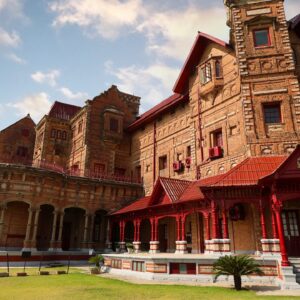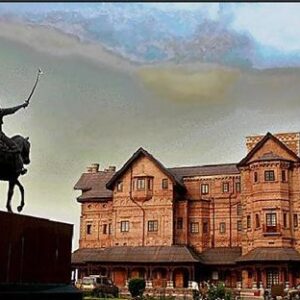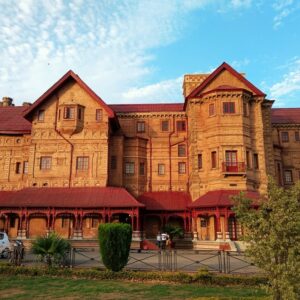Introduction
The Amar Mahal Palace is one of Jammu’s most magnificent heritage sites gently positioned on the River Tawi with the beautiful Himalayas as its backdrop. A combination of royal splendor, Indo-French architecture, and a centuries-old history, this magnificent palace-turned-museum is much more than just a tourist spot — it is a dive into the opulent past of the Dogra dynasty and the rich cultural history of Jammu and Kashmir.
A visit to the Amar Mahal Palace is a delightful experience, whether you are a history buff, art lover or architecture enthusiast or just a traveler looking to learn the stories of India’s princely states, as it captures the hearts and minds of its visitors. Once the royal residence of the Dogra kings, the palace today displays a variety of statues, paintings, manuscripts, and personal items of the royal family themselves, giving you a rare glimpse into a time filled with wealth and tradition.
In this complete Travelogear Holidays travel guide, we will share with you the palace’s history, architectural features, treasures in the museum, tips for visiting, as well as everything you will need to know in order to plan a fantastic visit to one of Jammu’s crown jewels.



About Amar Mahal Palace – A Royal Landmark of Jammu
The Amar Mahal Palace stands out as one of the most important heritage sites in Jammu. Located atop a beautiful hill, overlooking the River Tawi, the palace provides unmatched views of the stunning hills and the city below. It was built for Maharaja Amar Singh in the 19th century and created by a French architect, so it has its unique combination of French château-style architecture with Indian royal creation.
Originally built for their royal residence the palace continued as a base for art, culture, and history. Today, it houses the Amar Mahal Museum and Library, which contains priceless collections from the Dogra era, including a royal collection of portraits, coins, miniature paintings, books, and personal collections of the Jammu royal family.
Historical Significance of Amar Mahal Palace
The story of Amar Mahal Palace is inextricably linked with the story of Dogra dynasty, one of the most notable dynasties of northern India. The palace was built in the 1890s on the orders of Maharaja Amar Singh, son of Maharaja Ranbir Singh and third ruler of the Dogra dynasty.
The palace was designed as an expensive royal residence, reflecting the power and stature of the Dogra rulers. After the reign of Maharaja Amar Singh, Maharaja Hari Singh, the last ruler of Jammu and Kashmir, lived at the palace for a while before independence in 1947.
In the later years, Maharani Tara Devi, the wife of Maharaja Hari Singh, played an integral role in changing the palace into a center of arts and culture. In 1975, she gave the palace to the Hari-Tara charitable trust, which is responsible now for the Amar Mahal Museum and Library.
Today, the palace symbolizes Jammu’s royal past and is a testament to the glory of the region’s past.
Architectural Marvel of Amar Mahal Palace
One of the most notable features of Amar Mahal Palace is its Indo-Eurpean architectural style, where one can see the palace is built from an earthy red sandstone and brick, and has characteristics of a French château such as dramatic, steeply sloped roofs , turrets, large towers, and elaborately worked woodwork.
Architectural highlights:
- French Château Design – The design of the palace is reminiscent of French Renaissance-style mansions characterized by pointed arches, steep gables, and tall windows.
- River View Location – The palace on a hilltop site provides dramatic views of the River Tawi and the Shivalik hills.
- Ornate Interiors – The interiors include elaborate wooden paneling, chandeliers, antique furniture, and royal portraits as a window to the past and glamorous life of an aristocrat.
- Grand Halls – Several of the rooms and halls of the palace were formerly the location of royal meetings, ceremonial functions, and social gatherings.
- Royal Garden – Surrounding the palace is a landscaped garden that has been planned with pathways and fountains providing a relaxing atmosphere for one walking through the garden.
The architectural quality of the European finesse and Indian opulence solidifies not only the palace is a historical monument but a visual masterpiece.
Amar Mahal Museum – A Treasure Trove of Royal Legacy
Presently, Amar Mahal Palace functions as a museum and library, which holds the art, culture, and history of the Dogra dynasty in Jammu and Kashmir. This museum is an essential stopover for visitors wanting to discover the royal history of Jammu and Kashmir.
Highlights and collections:
1. The Golden Throne
The most notable artifact in the museum is the Jammu Golden Throne, a luxurious golden throne, weighing 120 kg, that was used by the Dogra kings and queens, and is located under a glass enclosure. This majestic throne exemplifies the great power and magnificent lifestyle that was experienced while on the throne.
2. Royal Portrait Gallery
This section exhibits life-like oil paintings and portraits of the Dogra kings and queens that speak to their ancestry, customs, attitudes, and personalities.
3. Miniature paintings and artworks
A unique collection of Pahari, Kangra, or Mughal miniature paintings adorn the museum’s walls to represent an artistic tradition that has lasted centuries.
4. Manuscripts and rare books
Located in the library are impressive original collections of Sanskrit manuscripts, Persian manuscripts, and historical texts of Jammu and Kashmir’s political, cultural and social history.
5. Coins, Arms and artifacts
In this area are displayed numerous coins, royal ornaments, weapons, and ceremonial objects from the time of the Dogra’s rule showcasing their military and economic strength.
Exploring the museum is almost like going back in time — each the objects you observe sahaja and sometimes feel are experiencing life as it was many centuries ago.
Best Time to Visit Amar Mahal Palace
Amar Mahal Palace welcomes guests all year round, but the best time to visit will depend on the type of experience you wish to have.
1. Spring (March – May)
This season is best for touring around the palace as the weather is not as hot and gardens are often blooming and gorgeous. Spring is also a great time for photography and enjoying your experience outdoors.
2. Monsoon (June – September)
Following the monsoon rains, the palace and hills surrounding it will typically be lush and the colors will be vibrant. Monsoon season will have less tourists, however, daily rainfall can disrupt your plans.
3. Winter (October – February)
This is the perfect time to catch crisp weather and good visibility for commanding views of the landscape. Festivals and cultural events will often be taking place during this season.
**Pro Tip – for a better experience try and visit in the morning or later in the afternoon to take advantage of soft light and less tourists.
How to Reach Amar Mahal Palace
The palace is situated in Jammu city, conveniently around 4 km from the city center, and is easily accessible by all modes of transport.
By Air:
- Jammu Airport (Satwari Airport) is located approximately 8 km from the palace.
- There are regular flights connecting Jammu with Delhi, Mumbai, Chandigarh, and some other cities.
By Train:
- Jammu Tawi Railway Station is around 6 km from the palace.
- Taxis and auto-rickshaws are available outside the station.
By Road:
- The town is well connected by national highways from most major towns in North India.
- Local buses, taxis, and private vehicles can easily reach the palace.
Timings, Entry Fee & Visitor Information
- Visiting Hours: 10:00 AM – 5:00 PM (Closed on Mondays)
- Admission: Small fee (subject to change) for adults and children
- Photography: Allowed in designated areas (fee may apply)
- Suggestion: You can take a guided tour to learn more about the history of the palace and exhibits.
Things to Do at Amar Mahal Palace
If you make the proper arrangements, you stand to gain much more from your visit to Amar Mahal Palace. Here are the top things you should definitely not miss out:
1. See the Museum Exhibit: Spend time in each of the galleries designed to showcase the lifestyle and history of the Dogra dynasty.
2. See the Architecture: Move around the internal corridors, balconies, and gardens of the Palace where you will notice – and appreciate – the Indo-European architectural style.
3. See the Gold Throne: Undoubtedly, the 120 kg gold throne (the pride of the museum) is one of the most iconic aspects you will ever see.
4. Visit the Library: If you are a history lover, the Palace Library contains some rare manuscripts and books. [give me this in numbers]
5. Take Pictures: You can get a range of panoramic and scenic views of the Tawi River Valley and the Shivalik hills just from the home terrace of the Palace.
6. Evening Cultural Events: From time to time, the Palace features art exhibits, cultural festivals, academic conferences, and outdoor cultural events.
Nearby Attractions
You can pair your trip to Amar Mahal Palace with other renowned places in Jammu, including:
- Raghunath Temple: One of the largest temple complexes in Northern India.
- Bahu Fort and Bagh-e-Bahu: An ancient fort structure with a large, relaxed Mughal-style garden.
- Ranbireshwar Temple: A temple dedicated to Lord Shiva, most well known for its size massive Shivalingas.
- Mubarak Mandi Palace: Another royal palace exhibiting Dogra-era architecture.
- Peer Kho Cave Temple: A historically significant cave temple with an origin dedicated to Lord Shiva.
Travel Tips for Visitors
- Allow approximately 1-2 hours to explore the museum and palace grounds in detail.
- Wear walking shoes that you are comfortable in.
- Visit the museum during the week, if possible, to avoid larger crowds on weekends and holidays.
- Keep an eye out for temporary exhibitions/events you may be able to enjoy, as they can elevate your experience immensely.
- Consider hiring a local guide to hear the lee of the palace and to learn about some of its stories and secrets.
Why Visit Amar Mahal Palace with Travelogear Holidays
Discovering Amar Mahal Palace will be an experience to remember as Travelogear Holidays will help you explore. Our custom Jammu heritage tours include guided tours of the palace, local sightseeing and transport, and a deep understanding of the history and culture of Dogra. Your experience will not just be a sightseeing trip: with Travelogear Holidays it will be the eastern way of experiencing the soul of Jammu’s royal past.
Conclusion
The Amar Mahal Palace is more than a building—it is a vivid encapsulation of Jammu’s royal past. With magnificent structure, cultural displays, cultural artifacts, and spectacular vistas of Tawi River and Himalayas, you will experience a totally immersive experience of grandeur of an epoch. Whether you are a history buff, culture aficionado, art lover, or just the casual traveler, you cannot afford to miss a visit to the Amar Mahal Palace for your Jammu trip.
And with Travelogear Holidays as your trusted travel facilitator, you will enjoy a seamless and enriching journey to the regal heart of Jammu and Kashmir.
Top 10 FAQs about Amar Mahal Palace Jammu
1. Who built the Amar Mahal Palace?
It was commissioned by Maharaja Amar Singh of the Dogra dynasty in the late 19th century.
2. What is the Amar Mahal Palace famous for?
It’s renowned for its Indo-French architecture, royal museum, and the 120-kg golden throne.
3. Is photography allowed inside the palace?
Yes, but certain sections may require an additional photography fee.
4. What are the opening hours of the museum?
The museum is open from 10:00 AM to 5:00 PM, except Mondays.
5. How far is the palace from Jammu Airport?
It’s approximately 8 km from Jammu Airport.
6. How much time is required to explore the palace?
About 1–2 hours is sufficient for a thorough visit.
7. Are guided tours available at the museum?
Yes, guided tours are available and highly recommended.
8. Can children visit the palace museum?
Absolutely, it’s a family-friendly attraction with educational value.
9. Is there an entry fee for Amar Mahal Palace?
Yes, there’s a nominal fee for adults and children.
10. What’s the best time to visit Amar Mahal Palace?
Spring (March–May) and winter (October–February) offer the most pleasant weather and scenic views.
How to book Amar Mahal Palace Tour Packages With Travelogear Holidays?
For a seamless and exceptional booking experience,
Contact Travelogear Holidays at: reservationtravelogearholidays@gmail.com or call us at : 9906903196

